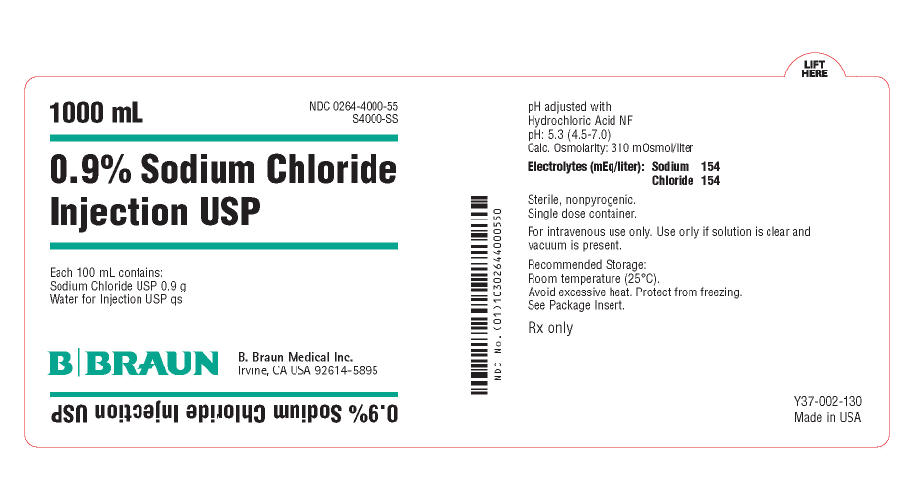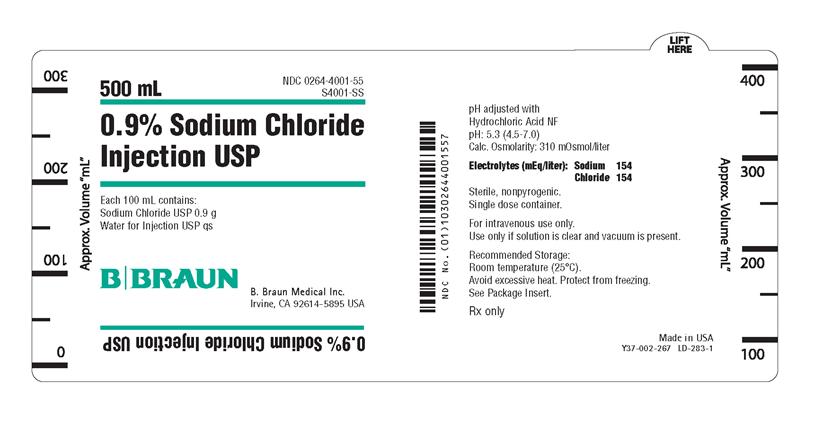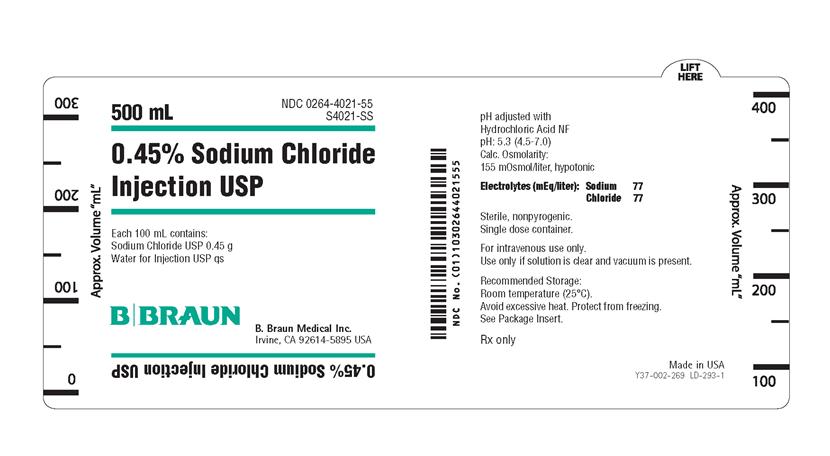SODIUM CHLORIDE- sodium chloride solution
B. Braun Medical Inc.
Disclaimer: This drug has not been found by FDA to be safe and effective, and this labeling has not been approved by FDA. For further information about unapproved drugs, click here.
----------
Sodium Chloride
Injections USP
DESCRIPTION
Each 100 mL of 0.9% Sodium Chloride Injection USP contains:
Sodium Chloride USP 0.9 g; Water for Injection USP qs
pH: 5.3 (4.5–7.0); Calculated Osmolarity: 310 mOsmol/liter
pH adjusted with Hydrochloric Acid NF
Concentration of Electrolytes (mEq/liter): Sodium 154; Chloride 154
Each 100 mL of 0.45% Sodium Chloride Injection USP contains:
Sodium Chloride USP 0.45 g; Water for Injection USP qs
pH: 5.3 (4.5–7.0); Calculated Osmolarity: 155 mOsmol/liter, hypotonic
pH adjusted with Hydrochloric Acid NF
Concentration of Electrolytes (mEq/liter): Sodium 77; Chloride 77
Sodium Chloride Injections USP are sterile, nonpyrogenic, and contain no bacteriostatic or antimicrobial agents.
The formula of the active ingredient is:
| Ingredient | Molecular Formula | Molecular Weight |
|---|---|---|
| Sodium Chloride USP | NaCl | 58.44 |
CLINICAL PHARMACOLOGY
Sodium Chloride Injections USP provide electrolytes and are a source of water for hydration. They are capable of inducing diuresis depending on the clinical condition of the patient.
Sodium, the major cation of the extracellular fluid, functions primarily in the control of water distribution, fluid balance, and osmotic pressure of body fluids. Sodium is also associated with chloride and bicarbonate in the regulation of the acid-base equilibrium of body fluid.
Chloride, the major extracellular anion, closely follows the metabolism of sodium, and changes in the acid-base balance of the body are reflected by changes in the chloride concentration.
INDICATIONS AND USAGE
These intravenous solutions are indicated for use in adults and pediatric patients as sources of electrolytes and water for hydration.
0.9% Sodium Chloride Injection USP is indicated for extracellular fluid replacement, treatment of metabolic alkalosis in the presence of fluid loss, and mild sodium depletion.
0.9% Sodium Chloride Injection USP is also indicated for use as a priming solution in hemodialysis procedures, and may be used to initiate and terminate blood transfusions without hemolyzing red blood cells.
0.45% Sodium Chloride Injection USP is primarily a hydrating solution and may be used to assess the status of the kidneys, since more water is provided than is required for excretion of salt. It may also be used in the treatment of hyperosmolar diabetes where the use of dextrose is inadvisable and there is a need for large amounts of fluid without an excess of sodium ions.
Sodium Chloride Injections USP are also indicated as pharmaceutic aids and diluents for the infusion of compatible drug additives. Refer to prescribing information accompanying additive drugs.
CONTRAINDICATIONS
These solutions are contraindicated where the administration of sodium or chloride could be clinically detrimental.
WARNINGS
The administration of intravenous solutions can cause fluid and/or solute overload resulting in dilution of serum electrolyte concentrations, overhydration, congested states or pulmonary edema. The risk of dilutional states is inversely proportional to the electrolyte concentration. The risk of solute overload causing congested states with peripheral and pulmonary edema is directly proportional to the electrolyte concentration.
Solutions containing sodium ions should be used with great care, if at all, in patients with congestive heart failure, severe renal insufficiency, and in clinical states in which there is sodium retention with edema. In patients with diminished renal function, administration of solutions containing sodium ions may result in sodium retention.
Infusion of isotonic (0.9%) sodium chloride during or immediately after surgery may result in excessive sodium retention. Use the patient's circulatory system status as a guide.
PRECAUTIONS
General
Clinical evaluation and periodic laboratory determinations are necessary to monitor changes in fluid balance, electrolyte concentrations, and acid-base balance during prolonged parenteral therapy or whenever the condition of the patient warrants such evaluation. Significant deviations from normal concentrations may require tailoring of the electrolyte pattern, in these or alternative solutions.
These solutions should be used with care in patients with hypervolemia, renal insufficiency, urinary tract obstruction, or impending or frank cardiac decompensation.
Extraordinary electrolyte losses such as may occur during protracted nasogastric suction, vomiting, diarrhea or gastrointestinal fistula drainage may necessitate additional electrolyte supplementation.
Additional essential electrolytes, minerals, and vitamins should be supplied as needed.
Sodium-containing solutions should be administered with caution to patients receiving corticosteroids or corticotropin, or to other salt-retaining patients. Care should be exercised in administering solutions containing sodium to patients with renal or cardiovascular insufficiency, with or without congestive heart failure, particularly if they are postoperative or elderly.
Infusion of more than one liter of isotonic (0.9%) sodium chloride per day may supply more sodium and chloride than normally found in serum, and can exceed normal tolerance, resulting in hypernatremia; this may also cause a loss of bicarbonate ions, resulting in an acidifying effect.
To minimize the risk of possible incompatibilities arising from mixing this solution with other additives that may be prescribed, the final infusate should be inspected for cloudiness or precipitation immediately after mixing, prior to administration, and periodically during administration.
If administration is controlled by a pumping device, care must be taken to discontinue pumping action before the container runs dry or air embolism may result.
These solutions are intended for intravenous administration using sterile equipment. It is recommended that intravenous administration apparatus be replaced at least once every 24 hours.
Use only if solution is clear and vacuum is present.
Carcinogenesis, Mutagenesis, Impairment of Fertility
Studies with Sodium Chloride Injections USP have not been performed to evaluate carcinogenic potential, mutagenic potential or effects on fertility.
Pregnancy
Teratogenic Effects
Pregnancy Category C
Animal reproduction studies have not been conducted with Sodium Chloride Injections USP. It is also not known whether Sodium Chloride Injections USP can cause fetal harm when administered to a pregnant woman or can affect reproduction capacity. Sodium Chloride Injections USP should be given to a pregnant woman only if clearly needed.
Nursing Mothers
It is not known whether this drug is excreted in human milk. Because many drugs are excreted in human milk, caution should be exercised when Sodium Chloride Injections USP are administered to a nursing woman.
Pediatric Use
Safety and effectiveness of sodium chloride injections in pediatric patients have not been established by adequate and well controlled trials, however, the use of electrolyte solutions in the pediatric population is referenced in the medical liturature. The warnings, precautions and adverse reactions identified in the label copy should be observed in the pediatric population.
Geriatric Use
An evaluation of current literature revealed no clinical experience identifying differences in response between elderly and younger patients.
In general, dose selection for an elderly patient should be cautious, usually starting at the low end of the dosing range, reflecting the greater frequency of decreased hepatic, renal, or cardiac function, and of concomitant disease or other drug therapy.
This drug is known to be substantially excreted by the kidney, and the risk of toxic reactions may be greater in patients with impaired renal function. Because elderly patients are more likely to have decreased renal function, care should be taken in dose selection, and it may be useful to monitor renal function.
ADVERSE REACTIONS
Reactions which may occur because of the solution or the technique of administration include febrile response, infection at the site of injection, venous thrombosis or phlebitis extending from the site of injection, extravasation, and hypervolemia.
Symptoms may result from an excess or deficit of one or more of the ions present in the solution; therefore, frequent monitoring of electrolyte levels is essential.
Hypernatremia may be associated with edema and exacerbation of congestive heart failure due to the retention of water, resulting in an expanded extracellular fluid volume.
If infused in large amounts, chloride ions may cause a loss of bicarbonate ions, resulting in an acidifying effect.
If an adverse reaction does occur, discontinue the infusion, evaluate the patient, institute appropriate therapeutic countermeasures and save the remainder of the fluid for examination if deemed necessary.
OVERDOSAGE
In the event of a fluid or solute overload during parenteral therapy, reevaluate the patient's condition, and institute appropriate corrective treatment.
DOSAGE AND ADMINISTRATION
These solutions are for intravenous use only.
Dosage is to be directed by a physician and is dependent upon age, weight, clinical condition of the patient and laboratory determinations. Frequent laboratory determinations and clinical evaluation are essential to monitor changes in blood glucose and electrolyte concentrations, and fluid and electrolyte balance during prolonged parenteral therapy.
In the average adult, daily requirements of sodium and chloride are met by the infusion of one liter of 0.9% sodium chloride (154 mEq each of sodium and chloride).
There is no specific pediatric dose. The dose is dependent on weight, clinical condition, and laboratory results. Follow recommendations of appropriate pediatric reference text. (See PRECAUTIONS, Pediatric Use.)
Fluid administration should be based on calculated maintenance or replacement fluid requirements for each patient.
0.9% Sodium Chloride Injection USP may also be administered intravascularly as a priming fluid in hemodialysis procedures.
When Sodium Chloride Injections USP are used as diluents for infusion of compatible drug additives, refer to dosage and administration information accompanying additive drugs.
Some additives may be incompatible. Consult with pharmacist. When introducing additives, use aseptic techniques. Mix thoroughly. Do not store.
Parenteral drug products should be inspected visually for particulate matter and discoloration prior to administration, whenever solution and container permit.
HOW SUPPLIED
Sodium Chloride Injections USP are supplied sterile and nonpyrogenic in full fill and partial fill glass containers with solid stoppers. The 1000 mL containers are packaged 6 per case; the 500 mL and 250 mL containers are packaged 12 per case.
| Container | ||||
|---|---|---|---|---|
| NDC | Cat. No. | Size | Fill | |
| 0.9% Sodium Chloride Injection USP | ||||
| 0264-4000-55 | S4000-SS | 1000 mL | 1000 mL | |
| 0264-4001-55 | S4001-SS | 500 mL | 500 mL | |
| 0264-4002-55 | S4002-15SS | 250 mL | 150 mL | |
| 0.45% Sodium Chloride Injection USP | ||||
| 0264-4021-55 | S4021-SS | 500 mL | 500 mL | |
Directions for Use of B. Braun Glass Containers
Designed for use with a vented set. Use 18 to 22 gauge needle size for spiking/admixing or withdrawing solutions from the glass bottle.
Before use, perform the following checks:
- Inspect each container. Read the label. Ensure solution is the one ordered and is within the expiration date.
- Invert container and carefully inspect the solution in good light for cloudiness, haze, or particulate matter; check the bottle for cracks or other damage. In checking for cracks, do not be confused by normal surface marks and seams on the bottom and sides of bottle. These are not flaws. Look for bright reflections that have depth and penetrate into the wall of the bottle. Reject any such bottle.
- To remove the outer closure, lift the tear tab and pull up, over, and down until it is below the stopper (see Figure 1). Use a circular pulling motion on the tab until it breaks away.

- Grasp and remove the metal disk, exercising caution not to touch the sterile surface underneath.
Warning: Some additives may be incompatible. Consult with pharmacist. When introducing additives, use aseptic techniques. Mix thoroughly. Do not store. - Refer to Directions for Use of the set being used. Insert the set spike into the large round outlet port of the stopper and hang container.
- After admixture and during administration, reinspect the solution frequently. If any evidence of solution contamination or instability is found or if the patient exhibits any signs of fever, chills or other reactions not readily explainable, discontinue administration immediately and notify the physician.
- When adding medication to the container during administration, swab the triangular medication site, inject medication and mix thoroughly by gentle agitation.
- Spiking, additions or transfers should be made immediately after exposing the sterile stopper surface. Check for vacuum at first puncture of stopper. Admixture by needle or syringe should be made through the triangular ( ∇ ) medication site; contents should be drawn by vacuum into the bottle. Admixture by spiked vial should be through the outlet port (See Figure 2). If contents of initial addition are not drawn into the bottle, vacuum is not present and the unit should be discarded. Each addition/transfer will reduce the vacuum remaining in the bottle.

- If the first puncture of the stopper is the administration set spike, insert the spike fully into the outlet port of the stopper and promptly invert the bottle. Verify vacuum by observing rising air bubbles. Do not use the bottle if vacuum is not present.
- If admixture or set insertion is not performed immediately following removal of protective metal disk, swab stopper surface.
- Distinction should be made between color (tint) and clarity (transparency). These solutions may be colored and are satisfactory for use if solution is clear and vacuum is present.
PRINCIPAL DISPLAY PANEL - 1000 mL Container Label
1000 mL
NDC 0264-4000-55
S4000-SS
0.9% Sodium Chloride
Injection USP
Each 100 mL contains:
Sodium Chloride USP 0.9 g
Water for Injection USP qs
B. Braun Medical Inc.
Irvine, CA USA 92614-5895
pH adjusted with
Hydrochloric Acid NF
pH: 5.3 (4.5-7.0)
Calc. Osmolarity: 310 mOsmol/liter
Electrolytes (mEq/liter): Sodium 154
Chloride 154
Sterile, nonpyrogenic.
Single dose container.
For intravenous use only. Use only if solution is clear and
vacuum is present.
Recommended Storage:
Room temperature (25°C).
Avoid excessive heat. Protect from freezing.
See Package Insert.
Rx only
Y37-002-130
Made in USA

PRINCIPAL DISPLAY PANEL - 500 mL Container Label
500 mL
NDC 0264-4001-55
S4001-SS
0.9% Sodium Chloride
Injection USP
Each 100 mL contains:
Sodium Chloride USP 0.9 g
Water for Injection USP qs
B. Braun Medical Inc.
Irvine, CA 92614-5895 USA
pH adjusted with
Hydrochloric Acid NF
pH: 5.3 (4.5-7.0)
Calc. Osmolarity: 310 mOsmol/liter
Electrolytes (mEq/liter): Sodium 154
Chloride 154
Sterile, nonpyrogenic.
Single dose container.
For intravenous use only.
Use only if solution is clear and vacuum is present.
Recommended Storage:
Room temperature (25°C).
Avoid excessive heat. Protect from freezing.
See Package Insert.
Rx only
Made in USA
Y37-002-267 LD-283-1

PRINCIPAL DISPLAY PANEL - 150 mL Container Label
150 mL
NDC 0264-4002-55
S4002-15SS
0.9%
Sodium Chloride
Injection USP
Partial Fill Container
Each 100 mL contains:
Sodium Chloride USP 0.9 g
Water for Injection USP qs
B. Braun Medical Inc.
Irvine, CA USA 92614-5895
pH adjusted with
Hydrochloric Acid NF
pH: 5.3 (4.5-7.0)
Calc. Osmolarity: 310 mOsmol/liter
Electrolytes (mEq/liter): Sodium 154
Chloride 154
Sterile, nonpyrogenic.
Single dose container.
For intravenous use only.
Use only if solution is clear and vacuum is present.
Recommended Storage:
Room temperature (25°C).
Avoid excessive heat. Protect from freezing.
See Package Insert.
Rx only
Y37-002-268
Made in USA

PRINCIPAL DISPLAY PANEL - 500 mL Container Label
500 mL
NDC 0264-4021-55
S4021-SS
0.45% Sodium Chloride
Injection USP
Each 100 mL contains:
Sodium Chloride USP 0.45 g
Water for Injection USP qs
B. Braun Medical Inc.
Irvine, CA 92614-5895 USA
pH adjusted with
Hydrochloric Acid NF
pH: 5.3 (4.5-7.0)
Calc. Osmolarity:
155 mOsmol/liter, hypotonic
Electrolytes (mEq/liter): Sodium 77
Chloride 77
Sterile, nonpyrogenic.
Single dose container.
For intravenous use only.
Use only if solution is clear and vacuum is present.
Recommended Storage:
Room temperature (25°C).
Avoid excessive heat. Protect from freezing.
See Package Insert.
Rx only
Made in USA
Y37-002-269 LD-293-1

| SODIUM CHLORIDE
sodium chloride solution |
||||||||||||||||||||
|
||||||||||||||||||||
|
||||||||||||||||||||
|
||||||||||||||||||||
|
||||||||||||||||||||
|
||||||||||||||||||||
| SODIUM CHLORIDE
sodium chloride solution |
||||||||||||||||||||
|
||||||||||||||||||||
|
||||||||||||||||||||
|
||||||||||||||||||||
|
||||||||||||||||||||
|
||||||||||||||||||||
| SODIUM CHLORIDE
sodium chloride solution |
||||||||||||||||||||
|
||||||||||||||||||||
|
||||||||||||||||||||
|
||||||||||||||||||||
|
||||||||||||||||||||
|
||||||||||||||||||||
| SODIUM CHLORIDE
sodium chloride solution |
||||||||||||||||||||
|
||||||||||||||||||||
|
||||||||||||||||||||
|
||||||||||||||||||||
|
||||||||||||||||||||
|
||||||||||||||||||||
| Labeler - B. Braun Medical Inc. (002397347) |